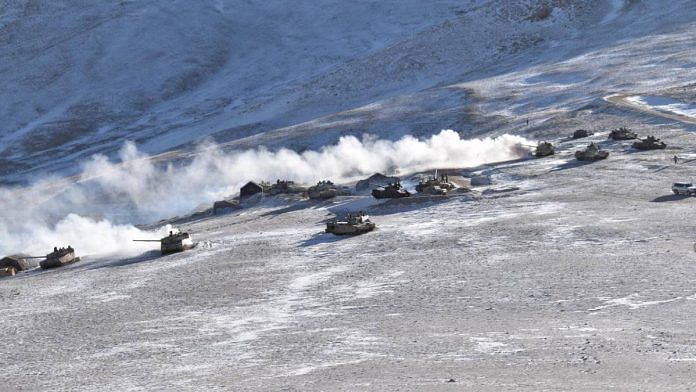
New Delhi: India and China have agreed to disengage in the Pangong Tso area in eastern Ladakh and go back to the status quo after nearly nine months of a stand-off, Defence Minister Rajnath Singh informed the Rajya Sabha Thursday as he explained what it entailed. In episode 681 of ‘Cut the Clutter’, ThePrint’s Editor-in-Chief, Shekhar Gupta refers to Singh’s statement as he explains the major turning points of this phase, the current attitudes of the two countries and some areas of vulnerability on both sides.
Rajnath Singh, in his Parliament speech, said that China and India have been talking for quite some time now about how to address this situation on the border. “(Singh) also recapitulates what happened in the beginning of April last year, how clashes piled up on both sides and how the Chinese tried to violate the Line of Actual Control in several places but they were stopped by Indian forces,” Gupta said.
Gupta added that something dramatic happened on the night of 29-30 August, when India carried out a night operation in which its well-trained troops went up the Kailash Range where the Chinese reacted sharply and there was a near clash. This eventually gave India a strong bargaining position.
“Three or four rounds of talks took place where the Chinese side was insisting that you (India) first withdraw from the southern bank positions, and then we will withdraw from the northern bank positions. India was insisting on everything being simultaneous,” Gupta explained.
Now, Indian Army visuals show that the Chinese tanks first started driving back, then Indian tanks started driving back and it’s fully calibrated. “These are evenly matched forces that are being withdrawn simultaneously,” Gupta said.
Gupta underlined the three points that India stands by: respect the Line of Actual Control (LAC) fully, no effort to alter the status quo and that all agreements regarding the LAC agreed upon by the two sides should be observed in their entirety.
Singh also said that within 48 hours of this military disengagement being completed, the military commanders of both sides will meet again to similarly resolve issues around other friction points on the LAC in Ladakh.
“Both sides will go back to their bases. And for now, all patrolling is suspended, which means that between Finger 4 and Finger 8, no side comes out to patrol,” Gupta said.
In October 2019, Gupta noted that owing to an “audacious” Indian Army officer, patrols were sent up to Finger 8. What the Chinese did on the north bank was a response to this.
Rajnath Singh said that both sides have now agreed that they will go back to their permanent and accepted bases, “which means any area which either side is just patrolling to establish its claim is right now out of the reckoning for both sides,” Gupta added. Singh also underlined how both sides have agreed that all the new structures they built in these areas will now be dismantled. And the land will be restored to what it was before these tensions started. Patrolling will resume only after both sides have made some basic agreements on maintaining peace and tranquillity.
Rajnath also said that no land was conceded to the Chinese. As of now, the friction points consist of the Gogra region, where Chinese military has troops 500 metres inside of what India considers the LAC to be. Another friction point is the Depsang Plains — this is important because it is tangible terrain for both sides. Gupta underlined two views on this region — one which says that China has denied India patrolling points and another view that says this region has been a point of contention for many years where both countries have obstructed each other.
Gupta ended by drawing a parallel between what the Chinese Ambassador to India Sun Weidong wrote in The Policy Chronicle and what Rajnath Singh said. Weidong said that boundary dispute should be put in its appropriate place, that it should be seen in a rational and constructive manner and that differences should not become disputes. In contrast, Rajnath Singh said that the boundary situation is central to the India-China bilateral relationship, that it can’t be that you have tensions or unsettled borders and carry on normally with your other relationships.
Watch the full episode here:
Subscribe to our channels on YouTube & Telegram
Why news media is in crisis & How you can fix it
India needs free, fair, non-hyphenated and questioning journalism even more as it faces multiple crises.
But the news media is in a crisis of its own. There have been brutal layoffs and pay-cuts. The best of journalism is shrinking, yielding to crude prime-time spectacle.
ThePrint has the finest young reporters, columnists and editors working for it. Sustaining journalism of this quality needs smart and thinking people like you to pay for it. Whether you live in India or overseas, you can do it here.